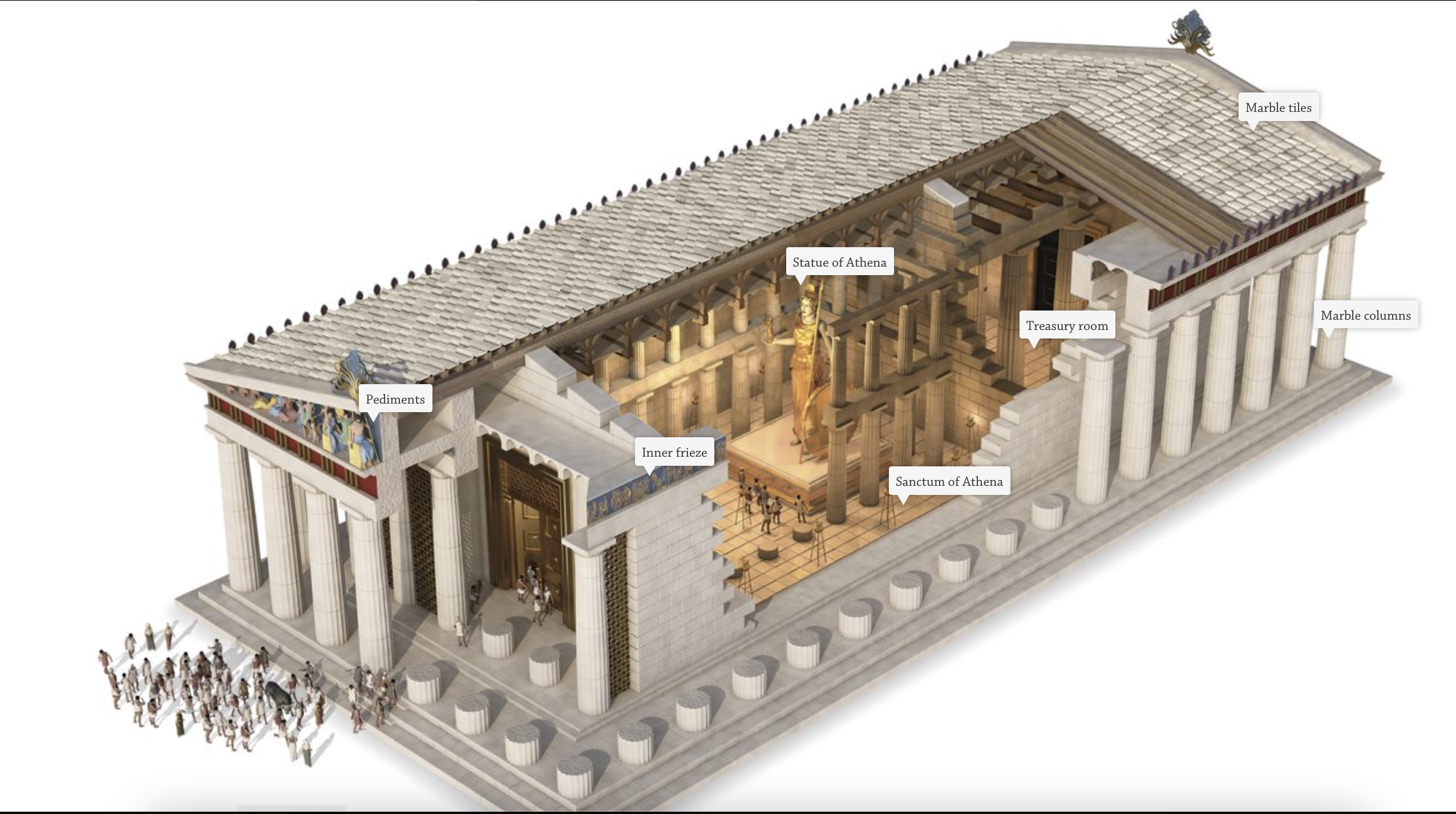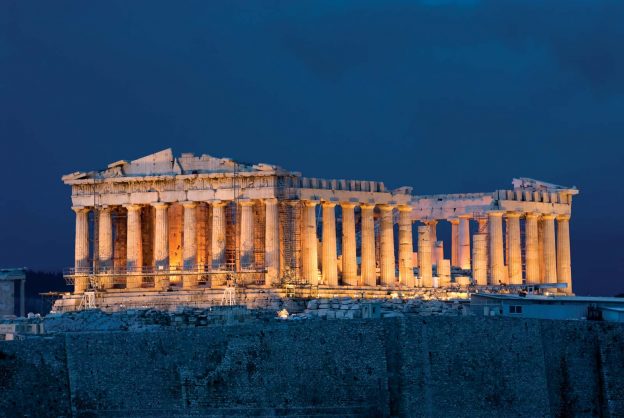Built from 447 to 432 BC under the direction of Pericles, the Parthenon stands as a spectacle of Greek architecture. In a sense, the temple was a redemption project, replacing the temple the Persians destroyed Persians in 480 BC during the Persian Wars. The Parthenon stands atop the Acropolis—the hill in Athens housing other temples dedicated to the Gods—overlooking the city of Athens. The Parthenon is a massive architectural feat around 101 feet wide and 228 feet long, with columns 34 feet high.

The Parthenon as it stands today
The Parthenon is a Doric peripteral temple, a style that includes steps leading up to a rectangular base and Doric-style columns around the structure’s perimeter. Some of the building is Ionic style, another form of Greek architecture. This could have been an intentional choice to reflect the unity of all Greeks under Athenian rule.

Exterior and interior of Parthenon
The Greeks strived for God-like perfection. To achieve this standard of perfection for the Parthenon, architects Iktinos and Kallikrates applied many mathematical tricks to ensure aesthetic perfection. Understanding the long vertical lines appear curved, horizontal parts of the structure are purposely curved to appear straight to the naked eye. Seventeen outer columns line the length of the structure on both sides, and eight columns support the front and back. Rather than traditional, straight columns, the columns in the Parthenon are curved so the center bulges. This prevents columns from looking narrower at the top, as well as adding dynamic movement to the building. In making the column curved, the building appears to bulge under the roof’s weight, as if the columns themselves were alive.
The point of the exterior structure was really to house a glistening statue of Athena in its cella or the innermost room of the temple. Constructed by the artist Pheidias, Athena’s massive gold and ivory statue was a sight to behold. Support columns line the walls of the cella, creating a dramatic backdrop to the stunning statue. In front of the statue was a reflection pool, providing humidity to prevent cracks in the statue. Only high-ranking members of society could enter the Parthenon, so the greater public never got to see the beauty it housed.
The exclusivity of the Parthenon explains the emphasis on exterior perfection: the Athenians wanted to impress all viewers, not just those who entered the temple. With the Parthenon, the Greeks erected a physical embodiment of perfection. With this perfection came power, might, and revenge—a collective goal in their society. Viewing the monument, onlookers are filled with awe at its sheer size and beauty. No matter where they come from, the visitors have no choice but to respect the Greeks for their perfect temple.
Works Cited
“Greece: Secrets of the Past – The Parthenon.” Canadian Museum of History, www.historymuseum.ca/cmc/exhibitions/civil/greece/gr1130e.html.
Hays, Jeffrey. “Parthenon: Its History, Architecture and Sculptures.” Facts and Details, factsanddetails.com/world/cat56/sub367/entry-6226.html.
Lee, Allison. “The Parthenon, Athena, and the Ideal Greek.” Ancient Art, 24 Apr. 2015, ancientart.as.ua.edu/the-parthenon-athena-and-the-ideal-greek/.
Lynch, Peter. “Optical Refinements at the Parthenon.” The Irish Times, The Irish Times, 21 June 2018, www.irishtimes.com/news/science/optical-refinements-at-the-parthenon-1.3531800.
“Parthenon Greece.” DK Find Out!, www.dkfindout.com/us/history/ancient-greece/parthenon/.
“Unlocking Mysteries of the Parthenon.” Smithsonian.com, Smithsonian Institution, 1 Feb. 2008, www.smithsonianmag.com/history/unlocking-mysteries-of-the-parthenon-16621015/.
Wasson, Donald L. “Phidias.” World History Encyclopedia, World History Encyclopedia, 23 May 2021, www.worldhistory.org/Phidias/.
Witte, Rachel. “The Parthenon Mythology and Architecture | DailyArt Magazine.” Daily Art Magazine , Google, 8 Sept. 2020, www.google.com/amp/s/www.dailyartmagazine.com/the-parthenon-mythology-and-architecture/amp/.
